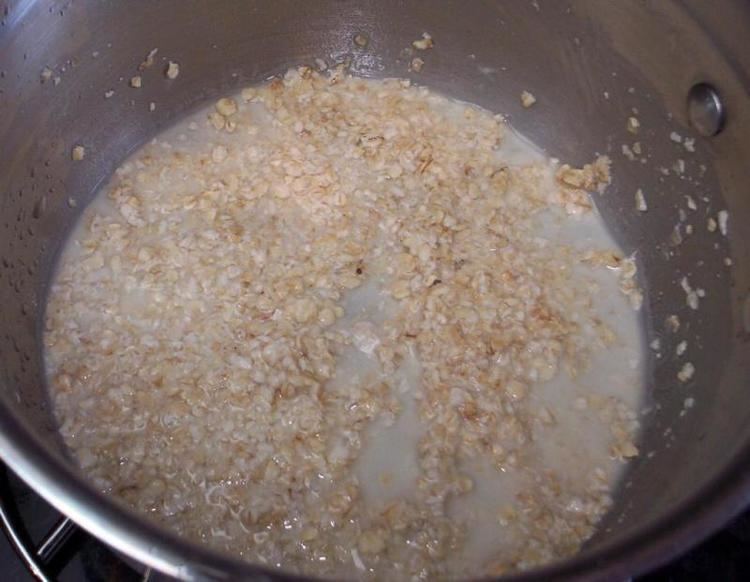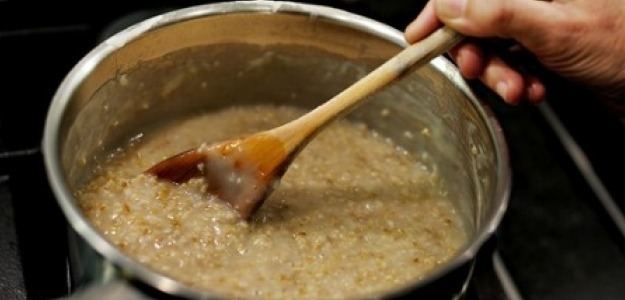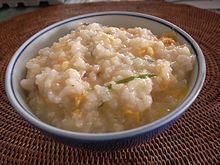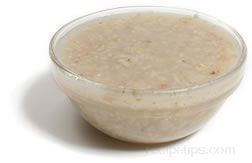Serving temperature Warm | Type Porridge Variations Congee | |
 | ||
Similar Porridge, Congee, Kolak, Bubur kacang hijau, Bubur ketan hitam | ||
Making puppy gruel
Gruel is a type of food consisting of some type of cereal—oat, wheat or rye flour, or rice—boiled in water or milk. It is a thinner version of porridge that may be more often drunk than eaten and may not need to be cooked. Historically, gruel has been a staple of the Western diet, especially for peasants. Gruel is often made from millet, hemp, barley or, in hard times, from chestnut flour or even the less bitter acorns of some oaks.
Contents
- Making puppy gruel
- Puppy s first solid foods foster dog fun with gruel
- History
- Etymology
- In fiction
- References

Though its actual medical use is not proven, the importance of gruel as a form of sustenance has historically been considered for the sick and recently weaned children. Hot malted milk is a form of gruel, although the manufacturers of such products as Ovaltine and Horlicks avoid calling it gruel, owing to the negative associations attached to the word in popular culture, as in Charles Dickens's novel Oliver Twist. From a literary, bourgeois, or modern point of view, gruel has often been associated with poverty. Gruel is also a colloquial expression for any watery or liquidy food of unknown character, e.g., pea soup. The word soup is derived from sop, the slice of bread which was soaked in broth or thin gruel.

Puppy s first solid foods foster dog fun with gruel
History

Gruel was the staple food of the ancient Greeks, for whom roasted meats were the extraordinary feast that followed sacrifice, even among heroes, and "In practice bread was a luxury eaten only in towns". Roman plebeians "ate the staple gruel of classical times, supplemented by oil, the humbler vegetables and salt fish", for gruel could be prepared without access to the communal ovens in which bread was baked. In the Middle Ages the peasant could avoid the tithe exacted, usually in kind, for grain ground by the miller of the landowner's mill by roasting the grains to make them digestible, and grinding small portions in a mortar at home. In lieu of cooking the resulting paste on the hearthstone, it could be simmered in a cauldron with water or, luxuriously, with milk.

In the Americas, maize gruels were once one of the main food sources for many Mesoamerican peoples, such as the Maya and Aztecs. Atole was a preparation of ground maize that was often flavored with chili and salt. It could be consumed or drunk as an important calorie source and as a thirst quencher.
Rice gruels eaten throughout Europe are normally referred to as congee from the Tamil word for the food.
Etymology

The Oxford English Dictionary gives an etymology of Middle English gruel from the same word in Old French, both of them deriving from a source in Late Latin: grutellum, a diminutive, as the form of the word demonstrates, possibly from an Old Frankish *grūt, surmised on the basis of a modern cognate grout.
In fiction

In the English-speaking world, gruel is remembered as the food of the child workhouse inmates in Charles Dickens's Industrial Revolution novel, Oliver Twist (1838); the workhouse was supplied with "an unlimited supply of water" and "small quantities of oatmeal". When Oliver asks the master of the workhouse for some more, he is struck a blow on the head for doing so. The "small saucepan of gruel" waiting upon Ebenezer Scrooge's hob in Dickens's 1843 novel A Christmas Carol emphasizes how miserly Scrooge is. References to gruel in popular culture today continue to refer to miserly or starvation conditions.
